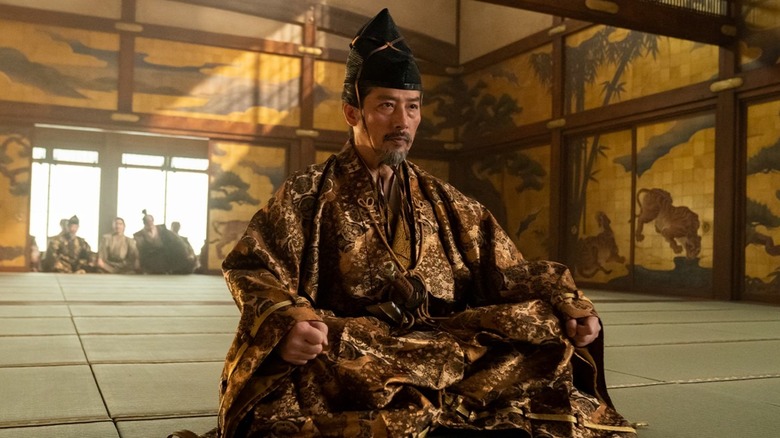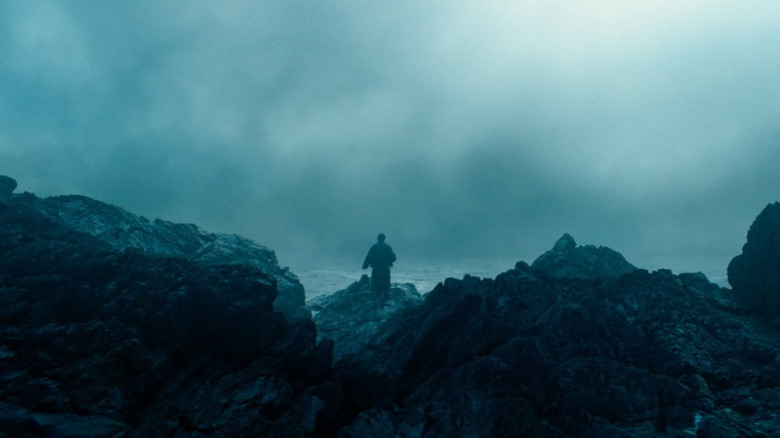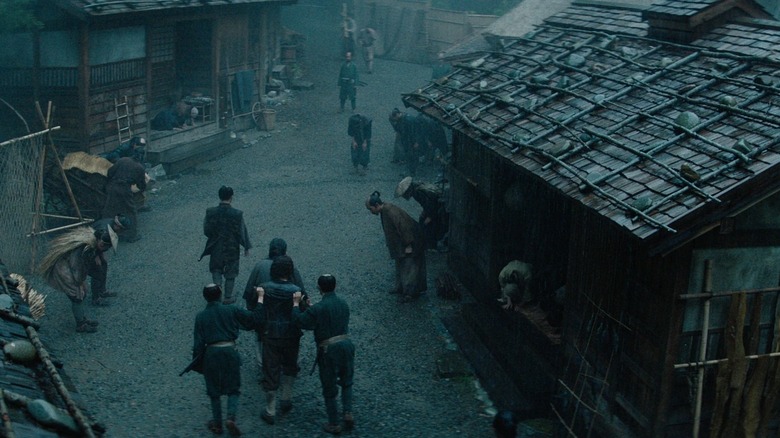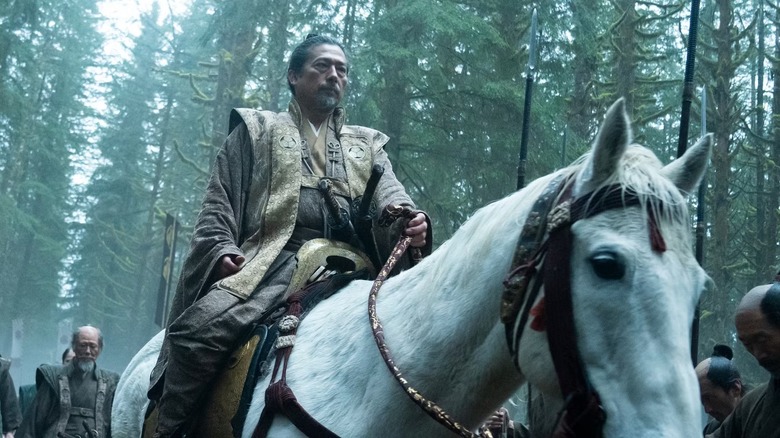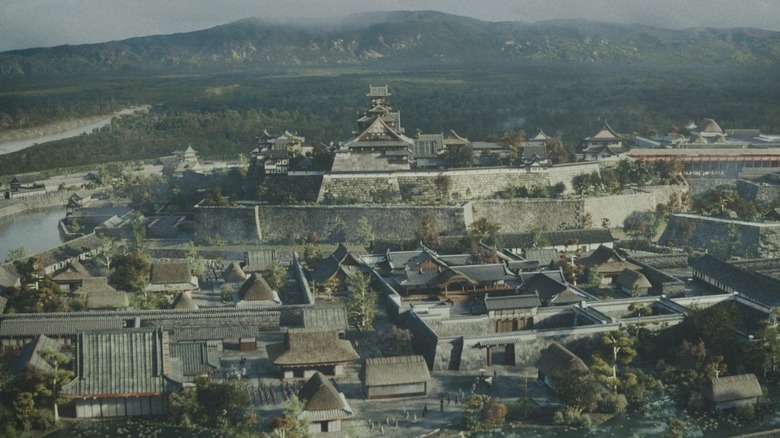Where Was Shōgun Filmed? Every Major Location Explained
FX's historical drama series "Shōgun" made waves with its 18 Emmy awards and a nearly perfect score on Rotten Tomatoes, causing the cable network to convert it from the miniseries it was originally created as by greenlighting two more seasons. Based on James Clavell's novel of the same name, the show follows Lord Yoshii Toranaga (Hiroyuki Sanada), a man at odds with his political adversaries in Osaka as he rules instead of the late emperor's child heir, and English maritime pilot John Blackthorne (Cosmo Jarvis), who finds himself Toranaga's captive after the ship he's on lands on the shores of the lord's lands.
The project, with its sweeping landscapes, beautiful sets, and amazing costumes, is a visually stunning show to watch, from Osaka Castle to the ships in the water. For those wondering where "Shōgun" was shot, it may come as a surprise to learn that, though it's set in Japan, the majority of the filming actually happened on the other side of the globe. Thanks to interviews with producers and the show's production designer, we know where the series was filmed. Get ready to plan your next trip, because here is every major location where "Shōgun" was shot.
Wya Point Beach in Ucluelet, British Columbia is seen in Shōgun's opening sequence
"Shōgun's" haunting opening sequence was shot on Wya Point Beach in Ucluelet, British Columbia. The scene is meant to take place in the Izu Peninsula, which is west of present-day Tokyo, Japan. The location features a rocky beach with fog-covered mountains further inland as a group of soldiers approaches the Erasmus, a trading ship. The Dutch ship is shown running aground on their shore and contains a crew who become prisoners of Lord Toranaga.
"We wanted to open the show with the beautiful scenery of the Wya Point Beach in Ucluelet," producer Erin Smith told CTV News while discussing the decision to film in Canada. "We have a lot of cast and crew from Japan that were quite fascinated and blown away by the resemblance of that spot to Japan." However, while the area worked well for early scenes, there were some logistical issues because Ucluelet is more of an island compared to the other major outdoor filming location in Canada the series used.
Several sets were built in Port Moody, British Columbia
Port Moody, British Columbia, Canada, was transformed into Osaka City and Ajiro, a fishing village. Production designer Helen Jarvis used the location of an old cedar factory, the Flavelle sawmill, as a starting point. While the mill had been in operation for over 100 years, it was closed down in 2020. After removing the logging equipment that was left behind, "Shōgun's" set-building team got to work on constructing the jetties that connect the land to the water and other necessary structures to recreate the show's Japanese setting. With the mountains in the background, the spot created the perfect environment to mimic Japan during the Edo period of 1600.
"With the city of Osaka, we would graduate from those buildings that were owned by the fishermen who lived right at the end of the water," Jarvis told Variety. "The buildings would grow, and as you approach the castle, the houses would get larger and more prestigious." The intent was to have more humble and simple homes right on the water, with the complexity of the buildings growing as they reached the castle in the distance. The outdoor spot also allowed them to build things to scale, so wall heights and such were realistic.
Lead actor and series producer Hiroyuki Sanada liked having the buildings to act in front of rather than green screens. "It was amazing. I'm so happy, as an actor, to have gotten to play in front of those real huge-scale sets," he said in an interview with Collider.
Soundstages and backlots in Vancouver, Canada were Osaka Castle
Though portions of the series were shot outside, soundstages and backlots in Vancouver were used to construct the various rooms inside Osaka Castle. While production designer Helen Jarvis discovered that these spaces had low, flat ceilings in her research, she made sure to have no ceilings on the rooms the show shot in, giving the team more room for filming. This decision not only gave the director more shooting options, but it also opened up the lighting of the rooms. "[I]t was a bit of a cheat, but the rationale was that the city of Osaka is still being built and we got some great lighting effects in the meeting hall," she explained to Variety. "It would have been difficult with a solid low ceiling."
About 700 shoji screens were used to construct the Osaka Castle set. The images on them are authentic, based on Jarvis' research, but they were printed, rather than individually hand-painted, due to time constraints. "For all of our panels, we painted them with a beautiful color with some metallic powders in it, and ran the panels through a very large format printer to print those gorgeous designs," she revealed.
The castle wasn't the only set built on soundstages. The samurai houses within Osaka City were also crafted there, as were the inside cabins of the series' larger ships. Because Jarvis did "Peter Pan and Wendy" just before "Shōgun," she started there, refurbishing some of the ship sets from the former project for the latter. Between her knowledge coming in, research, and the help of an expert on the topic of Japanese boat building, Douglas Brooks, they built everything, from small fishing boats to the Erasmus.
There was a single scene shot in London
While the majority of the series is filmed in Canada, there was a sequence that the production team shot in the United Kingdom, one of the originally planned filming locations. A scene when Lord Toranaga is riding on a horse was filmed in one day in London in 2019. This might seem like an odd choice, but it was an important decision that helped "Shōgun" become what it is today.
Production was originally going to begin in 2019. However, that start date was pushed back amid production delays and the decision to rework all of the scripts. There was an effort to shift the narrative so it wasn't simply a remake of the original 1980 adaptation. This led to the decision to reframe the story so it wasn't told from a Western perspective, a change that required several script revisions and working with consultants to ensure accurate representation and translations.
But, while this was happening, the clock was ticking. FX risked losing the rights to the project altogether if it didn't produce something by a contracted date, so Hiroyuki Sanada, who starred in and produced the series (and whom you might recognize from his stacked resume), and a crew went to London to shoot the scene with him riding the horse. This enabled FX to maintain the rights to the adaptation while the script revisions took place. "We shot just myself on the horse in front of the fire," Sanada told Variety. "And then we kept the rights to the novel, then waited for the next chance." It gave the team time to finish the revisions before the rest of filming finally kicked off in 2021.
Shōgun still filmed landscapes and establishing shots in Japan
The original plan was to carry out "Shōgun's" production in Japan, but everything was moved to Canada following production delays. Locations like Port Moody and Ucluelet were able to stand in as parts of Japan during the Edo period the series takes place in, but there were some landmarks and locations that the team needed to shoot that couldn't be recreated. Because of this, some Japanese landscape shots are used in the show, in addition to footage of various monuments that were not rebuilt on the sets in British Columbia.
Series co-creators Rachel Kondo and Justin Marks wanted to film in Japan, but just a few weeks after finishing the scripts, the world went into lockdown during the COVID-19 pandemic. "There were good things that came out of that, in terms of our process," Marks said in a behind-the-scenes article from The Walt Disney Company. "But the one real casualty was our ability to plausibly shoot this in Japan anytime over the next couple of years ... It meant that we had to, in a lot of ways, bring Japan to us."
